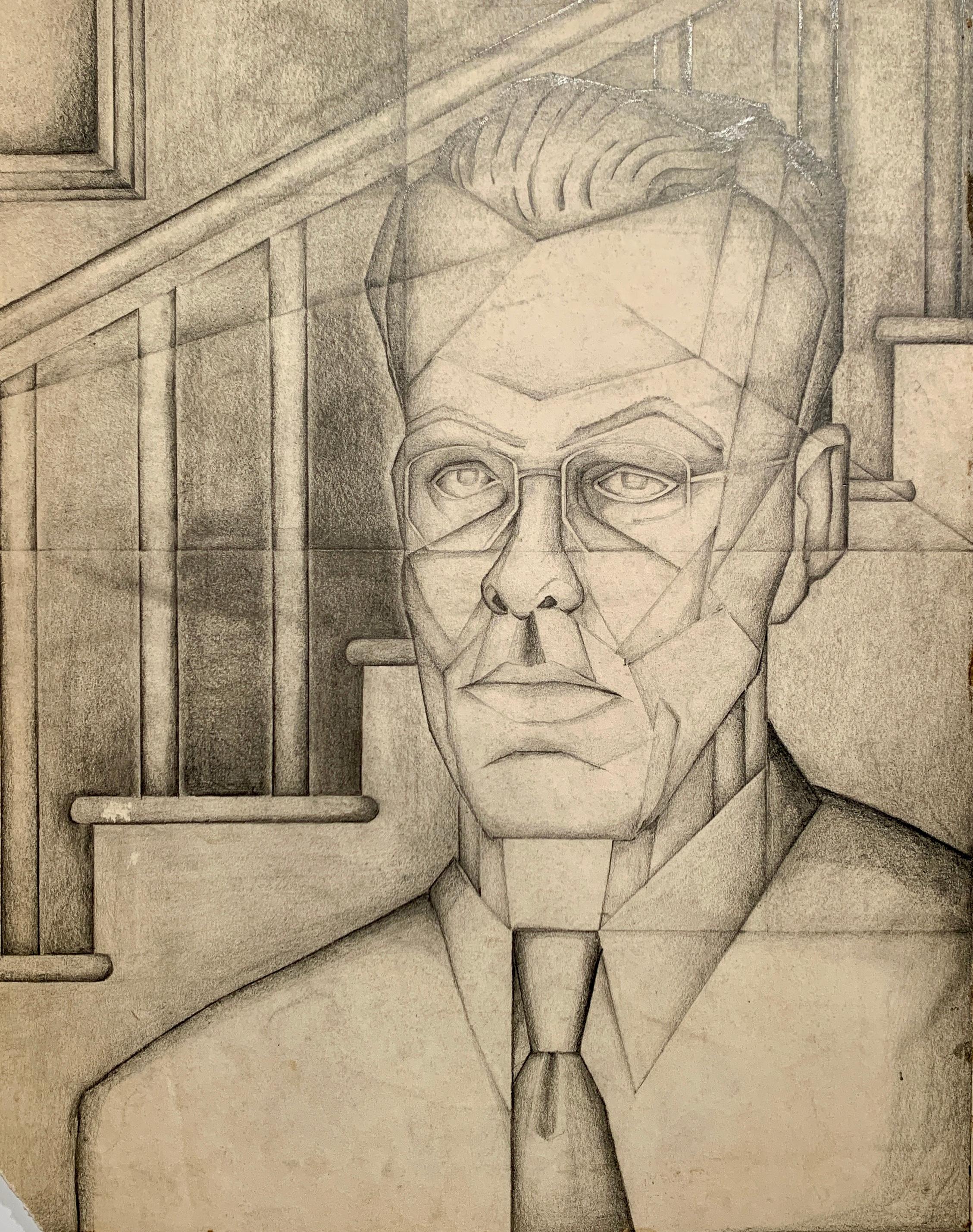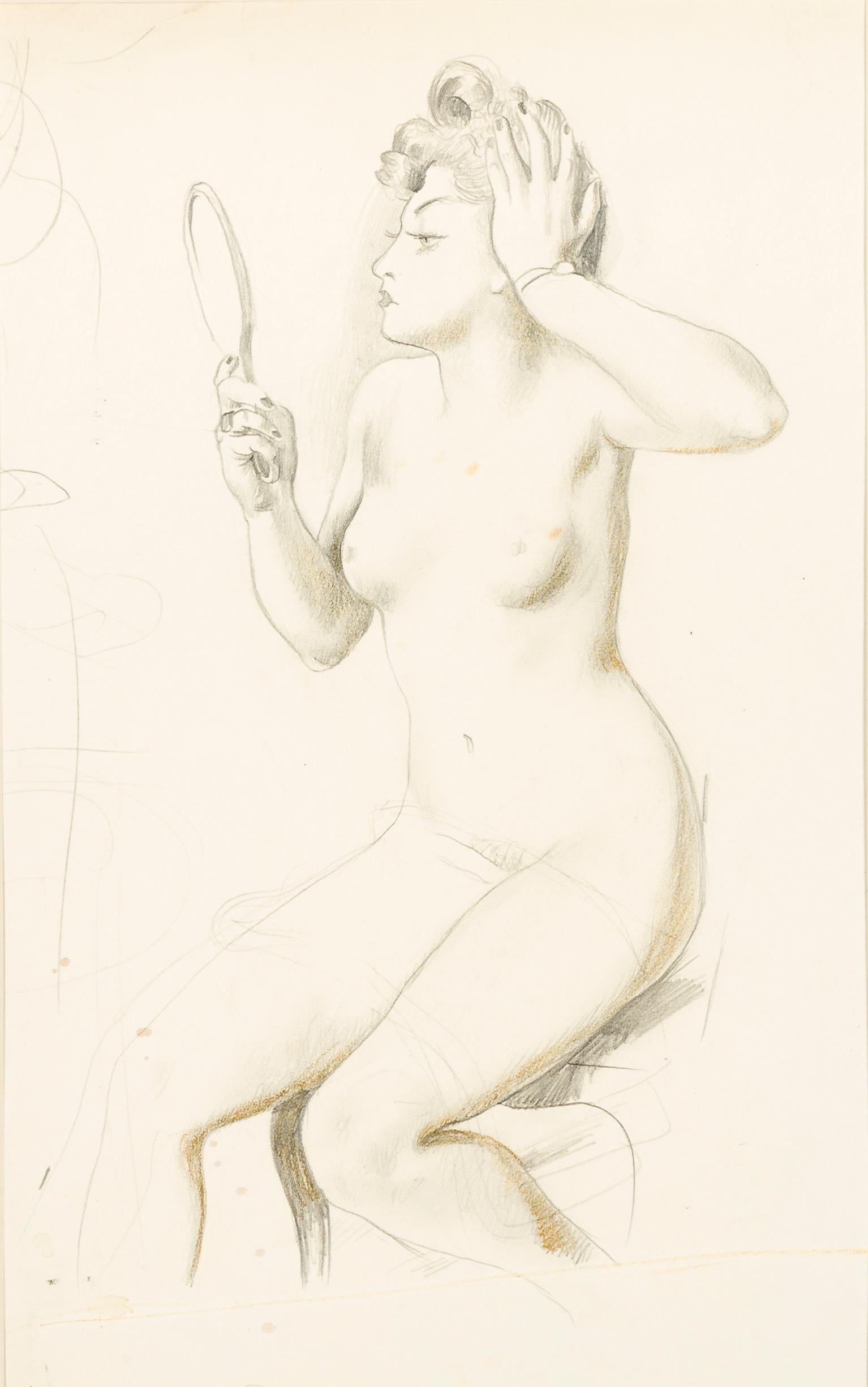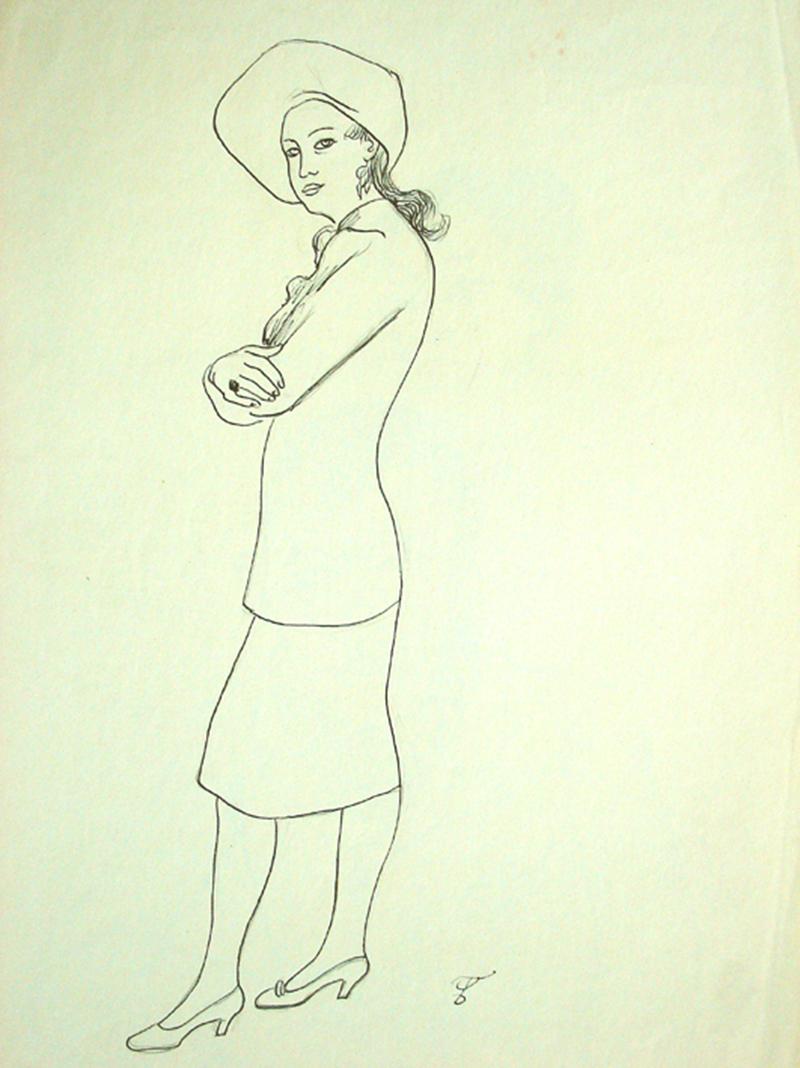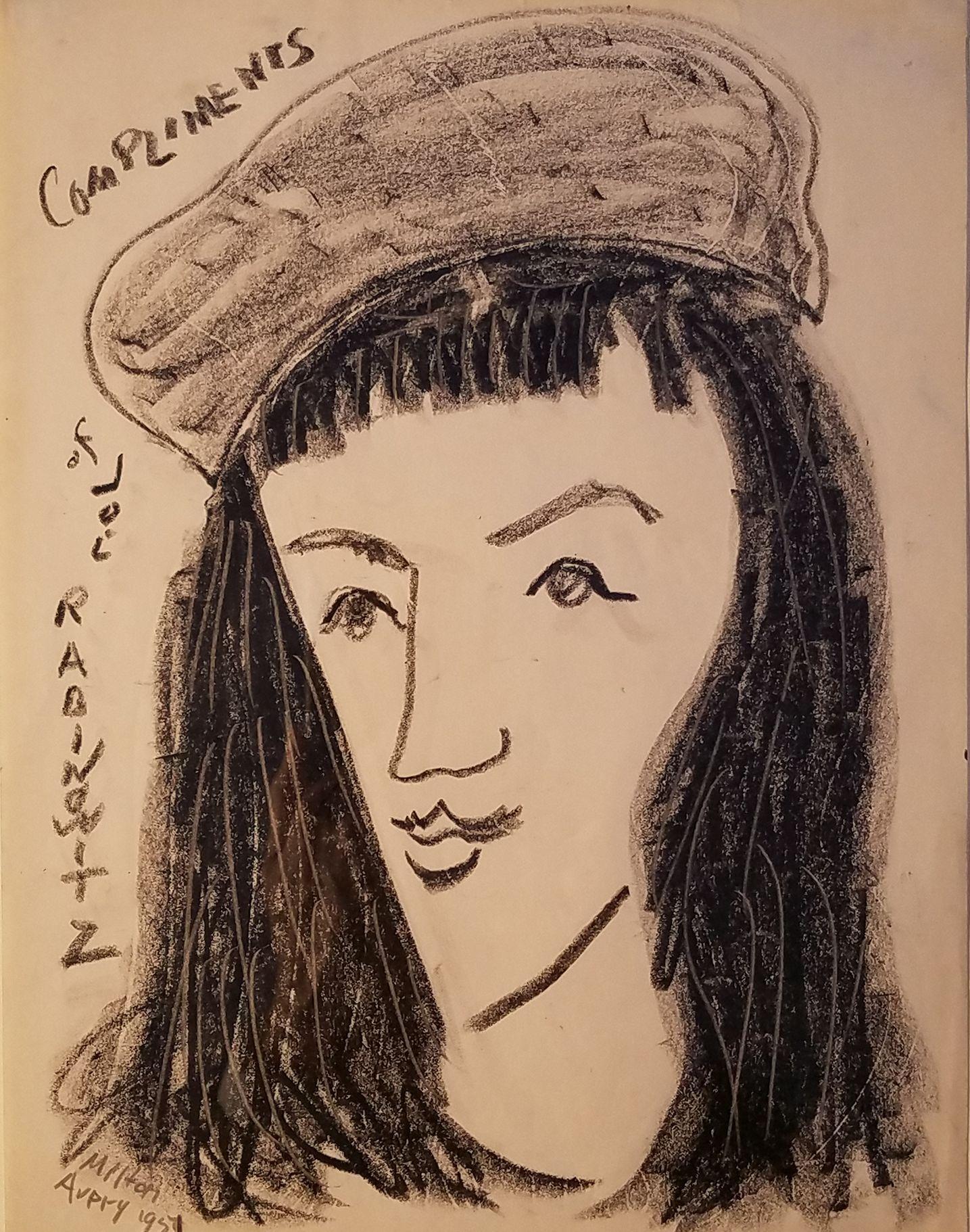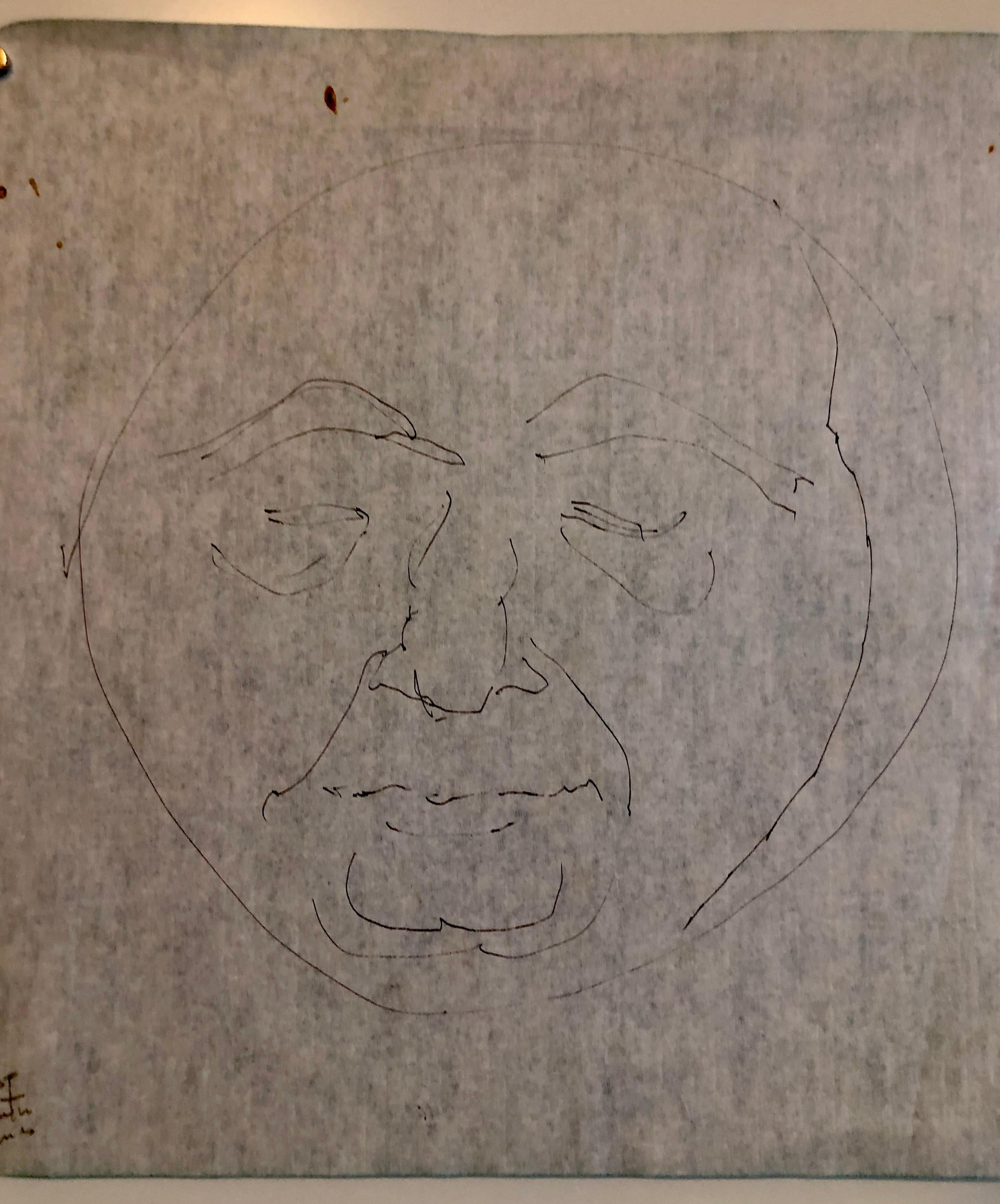Items Similar to French Modern Drawing by Jean Hélion - Veil Homme
Want more images or videos?
Request additional images or videos from the seller
1 of 8
Jean HélionFrench Modern Drawing by Jean Hélion - Veil Homme1947
1947
About the Item
Veil Homme
1947
drawing
26,9 x 21 cm
Registered on the catalogue raisonné with inventory number : N°0252 cat. B
sold without frame
about Jean Hélion (April 21, 1904 – October 27, 1987)
Jean Hélion was born on April 21, 1904, in Couterne, France. He entered the Institut Industriel du Nord in Lille to study chemistry in 1920 but left the following year to become an architectural apprentice in Paris. He painted while working as an architectural draftsman in the early 1920s. Hélion attracted the attention of the collector Georges Bine in 1925 and was soon able to devote himself entirely to painting. In 1927 he met Joaquín Torres-García, who collaborated on L'Acte, a short-lived magazine founded by Hélion and others.
Hélion first exhibited at the Salon des Indépendants in 1928. Shortly thereafter he became acquainted with Jean Arp, Piet Mondrian, and Antoine Pevsner. By 1929 his work was nonfigurative. With Theo van Doesburg and others in 1930 he formed the artists' association Art Concret and the periodical of the same name. This group was succeeded by Abstraction-Création the next year. In 1931, after traveling through Europe and the Soviet Union, Hélion returned to Paris, where he met Marcel Duchamp, Max Ernst, and Tristan Tzara. His first solo show was held at the Galerie Pierre in Paris in 1932. That same year Hélion made his first visit to New York, where he was given a solo exhibition at the John Becker Gallery at the end of 1933.
After returning to Europe from a second trip to the United States in 1934, he met Jacques Lipchitz, Joan Miró, and Ben Nicholson. In 1936 he settled in the United States, dividing his time between Virginia and New York. That year solo shows of his work took place at the Galerie Cahiers d'Art in Paris and the Valentine Gallery in New York. The artist traveled to Paris in 1938 on the occasion of his solo exhibition at the Galerie Pierre, and he became a friend of Paul Eluard, Matta, and Yves Tanguy. In 1939, he began integrating figurative elements into his work. This return to figuration was the hallmark of his postwar paintings.
Shortly after joining the French army in 1940 he was taken prisoner and sent to a camp in Pomerania and then Stettin. Hélion escaped in 1942 and that same year made his way to France and then the United States. His book They Shall Not Have Me was published in 1943, a year in which he was given solo shows at the Arts Club of Chicago and Peggy Guggenheim's Art of This Century, New York. Hélion returned to Paris in 1946. Throughout the 1950s and 1960s his work was shown in Europe and New York. During the 1970s he exhibited primarily in France. Hélion died on October 27, 1987, in Paris.
- Creator:Jean Hélion (1904 - 1987, French)
- Creation Year:1947
- Dimensions:Height: 10.6 in (26.9 cm)Width: 8.27 in (21 cm)Depth: 0.04 in (1 mm)
- Medium:
- Movement & Style:
- Period:
- Framing:Framing Options Available
- Condition:
- Gallery Location:Paris, FR
- Reference Number:1stDibs: LU108725553701
About the Seller
4.8
Platinum Seller
These expertly vetted sellers are 1stDibs' most experienced sellers and are rated highest by our customers.
Established in 2013
1stDibs seller since 2018
272 sales on 1stDibs
Typical response time: 2 hours
- ShippingRetrieving quote...Ships From: Paris, France
- Return PolicyA return for this item may be initiated within 30 days of delivery.
More From This SellerView All
- American Contemporary Art by Michael Alan - Essential WorkersBy Michael AlanLocated in Paris, IDFHand drawn and painted on digital photo Michael Alan is an American artist born in 1977 who lives & works in New York, USA. As a multidisciplinary artist. His work has been featured...Category
2010s Contemporary Portrait Drawings and Watercolors
MaterialsMixed Media, Photographic Paper
- American Contemporary Art by Michael Alan - Feel the BernBy Michael AlanLocated in Paris, IDFMixed media on paper Michael Alan is an American artist born in 1977 who lives & works in New York, USA. As a multidisciplinary artist. His work has been featured in many solo shows...Category
2010s Contemporary Portrait Drawings and Watercolors
MaterialsMixed Media, Paper
- British Contemporary Art by Helen Warner - Bouncing On IceLocated in Paris, IDFPencil on paper Helen Warner is a British artist born in 1978 who lives and works in Southampton, UK. She studied Art, Sport Studies and Human Biology at college and being a passion...Category
2010s Contemporary Figurative Drawings and Watercolors
MaterialsPencil, Paper
- French Contemporary Art by Francine Ledieu - FardeauxLocated in Paris, IDFPencil, black & brown chalk on paper Francine Ledieu is a French artist born in 1931 who lives and works in Paris, France. In the 50s, she was a student of Maurice Rocher who specia...Category
1960s Abstract Figurative Drawings and Watercolors
MaterialsPaper, Pencil, Chalk
- British Contemporary Art by Helen Warner - Strong HoldLocated in Paris, IDFPencil on paper Helen Warner is a British artist born in 1978 who lives and works in Southampton, UK. She studied Art, Sport Studies and Human Biology at...Category
2010s Contemporary Figurative Drawings and Watercolors
MaterialsPencil, Paper
- British Contemporary Art by Helen Warner - The Hammer Thrower IILocated in Paris, IDFPencil on paper Helen Warner is a British artist born in 1978 who lives and works in Southampton, UK. She studied Art, Sport Studies and Human Biology at college and being a passion...Category
2010s Contemporary Figurative Drawings and Watercolors
MaterialsPencil, Paper
You May Also Like
- 1940s Charcoal and Pencil Portrait of a ManLocated in Arp, TXArtist Unknown "Tie and Glasses" c. 1940s Charcoal and pencil on paper 13.5"x17" image 15.5"x19" paper unframed $250 Unsigned *Listed price reflects custom framing selected by seller...Category
1940s Modern Portrait Drawings and Watercolors
MaterialsPaper, Charcoal, Carbon Pencil
- Self Portrait (original signed drawing)By John HelikerLocated in New York, NYJohn Heliker Self Portrait, 1991 Charcoal Pencil on Paper (with original Kraushaar Galleries label verso) Signed on the front bears the original KRAUSHAAR GALLERIES label on the verso on the frame Vintage metal frame included Self portrait done in charcoal pencil by distinguished American artist John Heliker. Hand signed on the front This work is framed - bears the label of the renowned KRAUSHAAR GALLERIES on the verso. Image size: 13 inches by 10 inches; Framed: 18 1/2 inches by 14 1/2 inches About John Heliker from The New York Times Obituary, 2000 (Roberta Smith) John Heliker, a painter and teacher who was a fixture of the New York art world for nearly seven decades, died on Tuesday at the Sonojee Estate, a health center in Bar Harbor, Me. He was 91 and had lived in New York during most of his career, spending summers on Cranberry Island...Category
Late 20th Century Modern Portrait Drawings and Watercolors
MaterialsCharcoal, Carbon Pencil, Paper
- Akt mit HandspiegelBy August Wilhelm DresslerLocated in Wien, 9August Dressler is one of the painters of the New Objectivity. He is one of the lesser-known artists of the Weimar era, but he too, like his famous contemporaries Georg Grosz, John H...Category
20th Century Modern Figurative Drawings and Watercolors
MaterialsPencil, Paper
- Dame mit HutBy August Wilhelm DresslerLocated in Wien, 9August Dressler is one of the painters of the New Objectivity. He is one of the lesser-known artists of the Weimar era, but he too, like his famous contemporaries Georg Grosz, John H...Category
20th Century Modern Figurative Drawings and Watercolors
MaterialsPencil, Paper
- "March Avery in Beret, " Milton Avery, American Modernism, Portrait of ArtistBy Milton AveryLocated in New York, NYMilton Clark Avery (1885 - 1965) March Avery in a Beret, 1951 Black crayon and graphite on cream wove paper 11 x 8 3/8 inches Signed and dated lower left; ...Category
1950s American Modern Portrait Drawings and Watercolors
MaterialsPaper, Crayon, Pencil, Graphite
- Boston Abstract Expressionist Hyman Bloom Original Pencil Drawing Martin SumersBy Hyman BloomLocated in Surfside, FLThis is a unique artwork. This is an original Hyman Bloom drawing of fellow artist and his very good friend Martin Sumers.I believe this was drawn at the “variations of a theme” at Sumers gallery in NYC. The last two photos show a poster and a card from their shows. it is not included in this listing, it is just for provenance. Provenance: Acquired from the Sumers estate collection. Hyman Bloom (March 29, 1913 – August 26, 2009) was a Latvian-born American painter. His work was influenced by his Jewish heritage and Eastern religions as well as by artists including Altdorfer, Grünewald, Caravaggio, Rembrandt, Blake, Bresdin, James Ensor and Chaim Soutine. He first came to prominence when his work was included in the 1942 Museum of Modern Art exhibition "Americans 1942 -- 18 Artists from 9 States". MoMA purchased 2 paintings from the exhibition and Time magazine singled him out as a "striking discovery" in their exhibition review. His work was selected for both the 1948 and 1950 Venice Biennale exhibitions and his 1954 retrospective traveled from Boston's Institute of Contemporary Art to the Albright Gallery and the de Young Museum before closing out at The Whitney Museum of American Art in 1955. In a 1954 interview with Yale art professor Bernard Chaet, Willem de Kooning indicated that he and Jackson Pollock both considered Bloom to be “America’s first abstract expressionist”, a label that Bloom would disavow. Starting in the mid 1950s his work began to shift more towards works on paper and he exclusively focused on drawing throughout the 1960s, returning to painting in 1971. He continued both drawing and painting until his death in 2009 at the age of 9 Hyman Bloom (né Melamed) was born into an orthodox Jewish family in the tiny Jewish village of Brunavišķi in what is now Latvia, then part of the Russian Empire At a young age Bloom planned to become a rabbi, but his family could not find a suitable teacher. In the eighth grade he received a scholarship to a program for gifted high school students at the Museum of Fine Arts. He attended the Boston High School of Commerce, which was near the museum. He also took art classes at the West End Community Center, a settlement house. The classes were taught by Harold Zimmerman, a student at the School of the Museum of Fine Arts, who also taught the young Jack Levine at another settlement house in Roxbury. When Bloom was fifteen, he and Levine began studying with a well-known Harvard art professor, Denman Ross, who rented a studio for the purpose and paid the boys a weekly stipend to enable them to continue their studies rather than take jobs to support their families. He took Bloom and Levine on a field trip to the Museum of Modern Art in New York, where Bloom was impressed by the work of Rouault and Soutine and began experimenting with their expressive painting styles. In the 1930s Bloom worked sporadically for the Public Works of Art Project and the Federal Art Project (WPA), He shared a studio in the South End with Levine and another artist, Betty Chase. It was during this period that he developed a lifelong interest in Eastern philosophy and music, and in Theosophy. He first received national attention in 1942 when thirteen of his paintings were included in the Museum of Modern Art (MoMA) exhibition Americans 1942: 18 Artists from 9 States, curated by Dorothy Miller. MoMA purchased two of his paintings from that exhibition, and he was featured in Time magazine. The titles of his paintings in the exhibition reflect some of his recurring themes. Two were titled The Synagogue, another, Jew with the Torah; Bloom was actually criticized by one reviewer for including "stereotypical" Jewish images. He also had two paintings titled The Christmas Tree, and another titled The Chandelier, both subjects he returned to repeatedly. Another, Skeleton (c. 1936), was followed by a series of cadaver paintings in the forties, and The Fish (c. 1936) was one of many paintings and drawings of fish he created over the course of his career. Bloom was associated at first with the growing Abstract Expressionist movement. Willem de Kooning and Jackson Pollock, who first saw Bloom's work at the MoMA exhibition, considered Bloom "the first Abstract Expressionist artist in America." In 1950 he was chosen, along with the likes of de Kooning, Pollock, and Arshile Gorky, to represent the United States at the Venice Biennale. That same year Elaine de Kooning wrote about Bloom in ARTnews, noting that in paintings such as The Harpies, his work approached total abstraction: "the whole impact is carried in the boiling action of the pigment". In 1951 Thomas B. Hess reproduced Bloom's Archaeological Treasure in his first book, Abstract Painting: Background and American Phase, along with works by Picasso, Pollock, and others. Both de Kooning and Hess remarked on Bloom's expressive paint handling, a key characteristic of Abstract Expressionist painting. As abstract expressionism dominated the American art world, Bloom became disenchanted with it, calling it "emotional catharsis, with no intellectual basis." In addition, instead of moving to New York to pursue his career, he opted to stay in Boston. As a result he fell out of favor with critics and never achieved the kind of fame that Pollock and others did. He disliked self-promotion and never placed much value on critical acclaim. Many of Bloom's paintings feature rabbis, usually holding the Torah. According to Bloom, his intentions were more artistic than religious. He began questioning his Jewish faith early in life, and painted rabbis, he claimed, because that was what he knew. Over the course of his career he produced dozens of paintings of rabbis...Category
20th Century Modern Figurative Drawings and Watercolors
MaterialsPaper, Pencil
